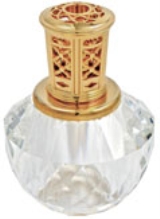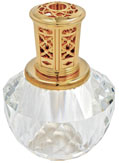
Fragrance lamp
Encyclopedia

The fragrance lamp's process is initiated by lighting the stone burner seated at the mouth of the lamp. After a few minutes the flame is extinguished by blowing it out, but the heated burner remains active as the flameless, low-temperature catalytic combustion process and diffused aromatics. The lamp does not operate with an open flame, making the fragrance lamp much safer to operate than scented candles. Its lower operating temperature
Operating temperature
An operating temperature is the temperature at which an electrical or mechanical device operates. The device will operate effectively within a specified temperature range which varies based on the device function and application context, and ranges from the minimum operating temperature to the...
also means that, unlike scented candles, the aromatics are diffused very efficiently into the ambient air without being burned. One of the by-products of these fragrance lamps is low-level ozone, which has been attributed to the "purification process" of the lamps in eliminating odor. In the last year a newer kind of catalytic burner was introduced called the Platinum Wick. This wick is all metal and produces the same diffusion effect with a catalytic screen that encircles the top of the wick.
It is difficult to verify the claim that scientific evidence supports the use of these lamps as it is difficult, if not impossible, to find the relevant research.
Hazard Warning
The lamp fuel contains 90% isopropyl alcoholIsopropyl alcohol
Isopropyl alcohol is a common name for a chemical compound with the molecular formula C3H8O. It is a colorless, flammable chemical compound with a strong odor...
and should be regarded as a highly flammable liquid. Furthermore, to start the catalytic wick according to the instruction it is necessary to light the catalytic burner with a flame and let it burn for approximately three minutes until it reaches the correct operating temperature. At this point the flame should be extinguished in order for the oil to be diffused. Precautions should be taken to avoid any possible hazards:
- Make sure the fuel container is in perfect condition, perfectly tight and not leaking.
- When not in use, make sure the airtight cap is on at all times to prevent evaporation (alcohol vapour/air mixture is highly flammable).
- Do not leave unattended during operation.
- Do not use in an unventilated room.
- Do not inhale, ingest, or use the lamp fuel in any other manner.
- Take extreme caution while refilling the fragrance lamp. Make sure there is ventilation, and that there is no open flame.
- In case of any spillage, wipe the area carefully before lighting the lamp.
- Do not fill lamps on wooden furniture or use a lamp without a dish underneath it. The fuel will damage furniture.
Potential Hazard from Ozone
- Ozone has been proven to trigger asthma, causing breathing difficulty and fatal to those in bad health condition.
- Ozone will be able to remove smell, virus and bacteria only in high concentration which is beyond public health standards.
- Ozone is very reactive; it will react with many chemical compounds and form a variety of aldehydes. In an experiment performed in 1992, total concentration of organic chemicals in the air increased rather than decreased after the introduction of ozone.

